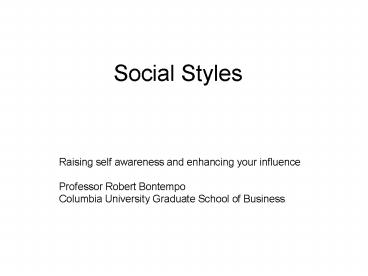Social Styles - PowerPoint PPT Presentation
1 / 22
Title:
Social Styles
Description:
ASSERTIVENESS - is a measure of the degree to which you see yourself ... opinionated, forceful; makes. statements and. declarations; directs actions. of others ... – PowerPoint PPT presentation
Number of Views:3127
Avg rating:5.0/5.0
Title: Social Styles
1
Social Styles
- Raising self awareness and enhancing your
influence - Professor Robert Bontempo
- Columbia University Graduate School of Business
2
ASSERTIVENESS - is a measure of the degree to
which you see yourself as tending to ask or as
tending to tell as you interact with
others. .
3
ASK ASSERTIVE cautious and reserved
about sharing opinions questioning low-key,
quiet
TELL ASSERTIVE opinionated, forceful
makes statements and declarations directs
actions of others
4
Assertiveness
ME
ASKS
TELLS
- Ask Assertive
- Slower pace
- Fewer Statements
- Quieter Volume
- Non-Directive/Relaxed Use of Hands
- Leans Back
- Indirect Eye Contact
- Tell Assertive
- Faster Pace
- More statements
- Louder Volume
- Directive Use of Hands/Points for Emphasis
- Leans forward
- Direct Eye Contact
5
RESPONSIVENESS - is a measure of the degree to
which you see yourself as tending to control -
i.e. keep your feelings and emotions inside - or,
it is the degree to which you emote - i.e.
outward display your feelings and emotions with
others.
6
CONTROL focus on ideas, things, data and tasks
tend not to share feelings publicly
EMOTE readily shares feelings expresses anger,
joy happiness, hurt feelings
7
Responsiveness
- More Controlling
- Monotone
- Task Subjects
- Facts/Data
- Less Use of Hands
- Rigid Posture
- Controlled Facial Expressions
CONTROLS
- More Emoting
- Inflections
- People Subjects
- Opinions/Stories
- More Use of Hands
- Casual Posture
- Animated Facial Expressions
ME
EMOTES
8
CONTROL focus on ideas, things, data and tasks
tend not to share feelings publicly
ASK ASSERTIVE cautious and reserved
about sharing opinions questioning low-key,
quiet
TELL ASSERTIVE opinionated, forceful
makes statements and declarations directs
actions of others
EMOTE readily shares feelings expresses anger,
joy happiness, hurt feelings
9
Verbal and Non-Verbal Cues
1. Monotone 2. Task Subjects 3. Facts/Data 4.
Less Hand Movement 5. Rigid Posture 6. Controlled
Facial Expressions
CONTROLS
1. Slower Pace 2. Fewer Statements 3. Quieter
Volume 4. Non-directive/Relaxed
Use of Hands 5. Leans Back 6. Indirect Eye
Contact
1. Faster Pace 2. More Statements 3. Louder
Volume 4. Directive Use of Hands/Points
for Emphasis 5. Leans Forward 6. Direct Eye
Contact
EMOTES
ASKS
TELLS
1. Inflections 2. People Subjects 3.
Opinions/Stories 4. More Hand Movement 5. Casual
Posture 6. Animated Facial Expressions
10
Social Styles
CONTROLS
Analytical
Driving
ASKS
TELLS
EMOTES
Amiable
Expressive
11
Analytical
Driving
Logical Thorough Serious Systematic Prudent
Pragmatic Efficient Decisive Candid Independent
CONTROLS
TELLS
ASKS
EMOTES
Expressive
Amiable
Cooperative Supportive Diplomatic Patient Loyal
Enthusiastic Spontaneous Outgoing Fun
loving Persuasive
12
Driving Style More Telling More Controlled
Behavior
CONTROL
ASK ASSERTIVE
TELL ASSERTIVE
- Present time frame
- Direct action
- Tends to avoid
- inaction
EMOTE
- Swift action
- Maximum effort to control
- Minimum concern for
- caution in relationships
13
Expressive Style More Telling More Emoting
Behavior
CONTROL
ASK ASSERTIVE
TELL ASSERTIVE
- Future time frame
- Impulsive action
- Tends to avoid
- isolation
EMOTE
- Rapid action
- Maximum effort to involve
- Minimum concern for
- routine
14
Amiable Style More Asking More Emoting Behavior
CONTROL
ASK ASSERTIVE
TELL ASSERTIVE
- Present time frame
- Supportive action
- Tends to avoid
- conflict
EMOTE
- Unhurried action
- Maximum effort to relate
- Minimum concern for
- affecting change
15
Analytical Style More Asking More Controlled
Behavior
CONTROL
ASK ASSERTIVE
TELL ASSERTIVE
- Historical time frame
- Cautious action
- Tends to avoid
- personal involvement
EMOTE
- Slow action
- Maximum effort to organize
- Minimum concern for
- relationships
16
Style Strength Risk
Analytical
Precise, systematic
Inflexible, nit picking
Amiable
Supportive, easygoing
Conforming, permissive
Expressive
Enthusastic, imaginative
Overbearing, unrealistic
Driver
Determined, objective
Domineering, unfeeling
17
Style Risk Advice
Analytical
Inflexible, nit picking
Decide, take a stand
Amiable
Conforming, permissive
Set/achieve goals, challenge others to do their
best
Expressive
Overbearing, unrealistic
Restrain yourself
Driver
Domineering, unfeeling
Listen to others
18
Uses Facts
Takes Risks
Avoids Risks
Uses Opinions
Reference Williams and Miller (2002). Change the
Way You Persuade, HBR.
19
If you are aDriver
And they are
20
If you are an Expressive
And they are
21
If you are an Amiable
And they are
22
If you arean Analytical
And they are

